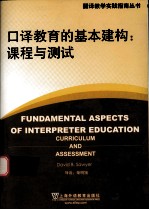

口译教育的基本建构 课程与测试PDF电子书下载
- 电子书积分:12 积分如何计算积分?
- 作 者:索亚著
- 出 版 社:上海:上海外语教育出版社
- 出版年份:2011
- ISBN:9787544620796
- 页数:310 页
CHAPTER 1 Introduction 1
1.Challenges facing interpreter education 3
2.The integrative role of assessment 5
3.The objectives of this book 9
4.Methodological considerations 10
5.Overview of contents 15
CHAPTER 2 Interpreter education literature 19
1.Curriculum 26
2.Expertise 29
3.Assessment 31
4.Language transfer competence 35
5.Conclusions 37
CHAPTER 3 Fundamental aspects of curriculum 39
1.Definitions 41
1.1 The official curriculum 41
1.2 The hidden curriculum 42
2.Foundations 43
2.1 Philosophy 44
2.2 History 46
2.3 Psychology 48
2.4 Sociology 49
3.Guidelines 50
3.1 Educational philosophy 53
3.2 The aims of instruction 55
3.3 Program goals 55
3.4 Teaching objectives 58
3.5 Curricular implications 59
4.Approaches 60
4.1 Scientific-curriculum as process 60
4.1.1 The computational view of the mind 61
4.1.2 Skills and abilities in Instructional Systems Design 63
4.1.3 The cognitive psychology of expertise 65
4.1.4 Levels of expertise in interpreting 70
4.1.5 Implications for curriculum sequencing 73
4.2 Humanistic-curriculum as interaction 74
4.2.1 A community of professional practice 75
4.2.2 Cognitive apprenticeship 76
4.2.3 Reflective practice 79
4.2.4 Situated cognition and learning 81
4.2.5 Implications for the learning environment 84
5.Models 85
5.1 Curriculum models according to Arjona 85
5.2 Curriculum components 88
6.Steps toward effective curriculum design 90
7.Conclusions 91
CHAPTER 4 Foundations of interpreter performance assessment 93
1.Concepts 95
1.1 Validity 95
1.2 Reliability 101
1.3 Subjective and objective testing 103
1.4 Measurement scales 105
1.5 Formative,summnative,and ipsative assessment 106
1.6 Test specifications 107
2.Integrating curriculum and assessment:Developmental milestones 108
2.1 Entry-level assessment 109
2.2 Intermediate assessment 112
2.3 Final assessment 113
3.Evidential bases of construct validity 114
3.1 Scientific approaches:Criteria 114
3.2 Humanistic approaches:Domain 116
3.3 Guidelines:Standards 118
4.Standardization in testing 119
5.Authenticity 121
6.Alternative assessment:Portfolios 125
7.Steps toward valid and reliable assessment 128
8.Conclusions 129
CHAPTER 5 Introduction to the case study 131
1.Research questions 131
2.General comments on method and scope 131
3.Content analysis of GSTI curriculum documents 133
3.1 Aims,goals,objectives 133
3.2 Process:Knowledge and skill sequencing 135
3.3 Interaction:Educational environment 142
3.4 Assessment and the curriculum 143
CHAPTER 6 Case study Part Ⅰ:Translation and interpretation competence 145
1.Introduction 145
2.Method 147
2.1 Quantitative description of curriculum in the GSTI 147
2.1.1 First-year curriculum for MATI and MACI 147
2.1.2 Second-year curriculum for MATI and MACI 149
2.1.3 Second-year translation coursework for MATI 151
2.1.4 Second-year interpretation coursework for MATI and MACI 153
2.1.5 Advanced-entry course of study 156
2.1.6 The GSTI hidden curriculum 156
2.2 Subjects 157
2.3 Materials-Professional Examinations in the GSTI 159
2.3.1 Text selection 161
2.3.2 Text delivery 161
2.3.3 Examinations in consecutive interpretation 162
2.3.4 Examinations in simultaneous interpretation 162
2.3.5 Jury composition 162
2.3.6 Scoring criteria 163
2.3.7 Scoring procedure 163
2.4 Procedures-data collection 163
2.5 Analysis 168
3.Results 169
4.Discussion 171
CHARTER 7 Case study Part Ⅱ:Survey of exam jury members 177
1.Introduction 177
2.Method 178
2.1 Subjects 178
2.2 Materials-survey content 178
2.2.1 Background of jury members 179
2.2.2 Exam procedures 179
2.2.3 Purpose of the exams 180
2.2.4 Assessment criteria 180
2.2.5 Jury conduct and role of external examiners 182
2.2.6 Additional comments 182
2.3 Procedures 182
2.3.1 Questionnaire design 182
2.3.2 Questionnaire administration 183
2.3.3 Return rate 183
2.4 Analysis 183
2.4.1 Data preparation 183
2.4.2 Data analysis 184
3.Results 184
4.Discussion 187
CHAPTER 8 Case study Part Ⅲ:Analysis of exam texts 191
1.Introduction 191
1.1 Analytical tools 191
1.2 Exam texts and the curriculum 192
1.3 Exam texts as documents 193
2.Method 194
2.1 The corpus 195
2.2 Procedures 196
2.3 Analysis 197
2.3.1 English source language materials 197
2.3.2 French source language materials 200
2.3.3 German source language materials 201
3.Results 203
3.1 Exam texts for consecutive interpretation 203
3.2 Exam texts for simultaneous interpretation 204
4.Discussion 204
4.1 Length 204
4.2 Propositional content 205
4.3 Illocutionary force 206
4.4 Conclusions 207
CHAPTER 9 Implications of the case study 209
1.Part Ⅰ:Translation and interpretation in the GSTI curriculum 209
2.Part Ⅱ:Standardization,authenticity,and professional judgement 210
3.Part Ⅲ: Exam materials and test method facets 212
4.Addressing the research questions 213
CHAPTER 10 Curriculum enhancement:An integrated Y-track model 215
1.Aims and goals of the curriculum 220
2.Integrated assessment 224
3.Curriculum as process 225
4.Curriculum as interaction 227
5.Flexibility and streamlining 228
Outlook:On the political and ethical consequences of test validation 231
Notes 237
APPENDICES 241
Appendix A 241
Appendix B 244
Appendix C 252
References 265
Name index 303
Subject index 307
- 《培智学校义务教育实验教科书教师教学用书 生活适应 二年级 上》人民教育出版社,课程教材研究所,特殊教育课程教材研究中心编著 2019
- 《中央财政支持提升专业服务产业发展能力项目水利工程专业课程建设成果 设施农业工程技术》赵英编 2018
- 《习近平总书记教育重要论述讲义》本书编写组 2020
- 《办好人民满意的教育 全国教育满意度调查报告》(中国)中国教育科学研究院 2019
- 《教育学考研应试宝典》徐影主编 2019
- 《语文教育教学实践探索》陈德收 2018
- 《家庭音乐素养教育》刘畅 2018
- 《学前教育学》王换成主编 2019
- 《近代体育游戏教育史料汇编 第1辑 1》王强主编 2016
- 《全国学前教育专业(新课程标准)“十三五”规划教材 简谱手风琴教程 第2版》(中国)杨克勤,王宝庆 2019
- 《中风偏瘫 脑萎缩 痴呆 最新治疗原则与方法》孙作东著 2004
- 《水面舰艇编队作战运筹分析》谭安胜著 2009
- 《王蒙文集 新版 35 评点《红楼梦》 上》王蒙著 2020
- 《TED说话的力量 世界优秀演讲者的口才秘诀》(坦桑)阿卡什·P.卡里亚著 2019
- 《燕堂夜话》蒋忠和著 2019
- 《经久》静水边著 2019
- 《魔法销售台词》(美)埃尔默·惠勒著 2019
- 《微表情密码》(波)卡西亚·韦佐夫斯基,(波)帕特里克·韦佐夫斯基著 2019
- 《看书琐记与作文秘诀》鲁迅著 2019
- 《酒国》莫言著 2019
- 《培智学校义务教育实验教科书教师教学用书 生活适应 二年级 上》人民教育出版社,课程教材研究所,特殊教育课程教材研究中心编著 2019
- 《习近平总书记教育重要论述讲义》本书编写组 2020
- 《办好人民满意的教育 全国教育满意度调查报告》(中国)中国教育科学研究院 2019
- 《教育学考研应试宝典》徐影主编 2019
- 《语文教育教学实践探索》陈德收 2018
- 《家庭音乐素养教育》刘畅 2018
- 《学前教育学》王换成主编 2019
- 《近代体育游戏教育史料汇编 第1辑 1》王强主编 2016
- 《全国学前教育专业(新课程标准)“十三五”规划教材 简谱手风琴教程 第2版》(中国)杨克勤,王宝庆 2019
- 《现代教育技术》李志河主编 2019
